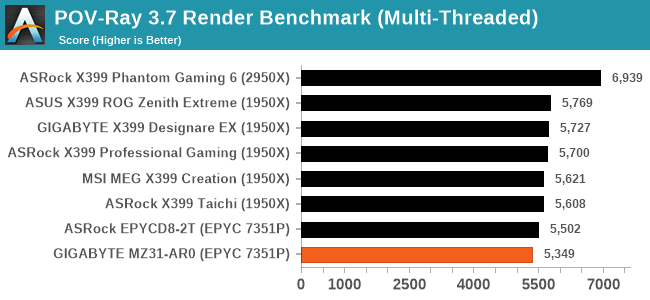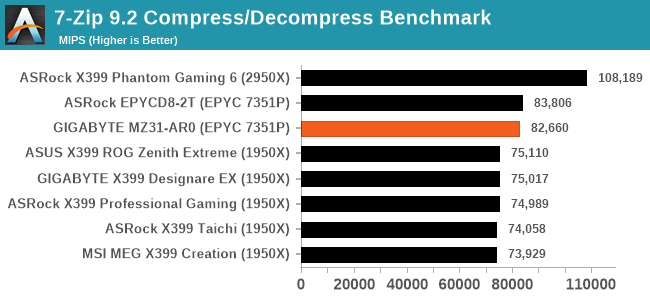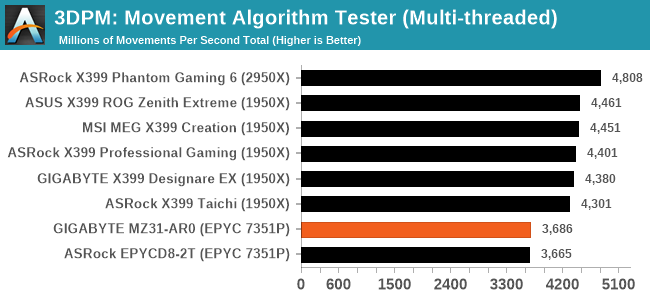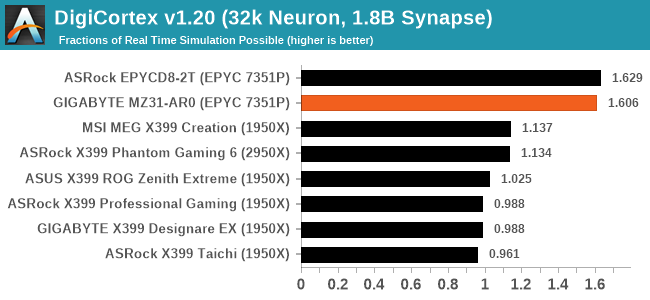The GIGABYTE MZ31-AR0 Motherboard Review: EPYC with Dual 10G
by Gavin Bonshor on March 25, 2020 1:15 PM ESTCPU Performance, Short Form
For our motherboard reviews, we use our short form testing method. These tests usually focus on if a motherboard is using MultiCore Turbo (the feature used to have maximum turbo on at all times, giving a frequency advantage), or if there are slight gains to be had from tweaking the firmware. We put the memory settings at the CPU manufacturers suggested frequency, making it very easy to see which motherboards have MCT enabled by default.
For this review we are running using Windows 10 64-bit with the 1909 update as per our Ryzen Threadripper 3960X and 3970X CPU review.
Rendering - Blender 2.7b: 3D Creation Suite - link
A high profile rendering tool, Blender is open-source allowing for massive amounts of configurability, and is used by a number of high-profile animation studios worldwide. The organization recently released a Blender benchmark package, a couple of weeks after we had narrowed our Blender test for our new suite, however their test can take over an hour. For our results, we run one of the sub-tests in that suite through the command line - a standard ‘bmw27’ scene in CPU only mode, and measure the time to complete the render.

Rendering – POV-Ray 3.7.1: Ray Tracing - link
The Persistence of Vision Ray Tracer, or POV-Ray, is a freeware package for as the name suggests, ray tracing. It is a pure renderer, rather than modeling software, but the latest beta version contains a handy benchmark for stressing all processing threads on a platform. We have been using this test in motherboard reviews to test memory stability at various CPU speeds to good effect – if it passes the test, the IMC in the CPU is stable for a given CPU speed. As a CPU test, it runs for approximately 1-2 minutes on high-end platforms.

Synthetic – 7-Zip v1805: link
Out of our compression/decompression tool tests, 7-zip is the most requested and comes with a built-in benchmark. For our test suite, we’ve pulled the latest version of the software and we run the benchmark from the command line, reporting the compression, decompression, and a combined score.
It is noted in this benchmark that the latest multi-die processors have very bi-modal performance between compression and decompression, performing well in one and badly in the other. There are also discussions around how the Windows Scheduler is implementing every thread. As we get more results, it will be interesting to see how this plays out.

Point Calculations – 3D Movement Algorithm Test: link
3DPM is a self-penned benchmark, taking basic 3D movement algorithms used in Brownian Motion simulations and testing them for speed. High floating point performance, MHz, and IPC win in the single thread version, whereas the multithread version has to handle the threads and loves more cores. For a brief explanation of the platform agnostic coding behind this benchmark, see my forum post here.

Neuron Simulation - DigiCortex v1.20: link
The newest benchmark in our suite is DigiCortex, a simulation of biologically plausible neural network circuits, and simulates activity of neurons and synapses. DigiCortex relies heavily on a mix of DRAM speed and computational throughput, indicating that systems which apply memory profiles properly should benefit and those that play fast and loose with overclocking settings might get some extra speed up. Results are taken during the steady-state period in a 32k neuron simulation and represented as a function of the ability to simulate in real time (1.000x equals real-time).











37 Comments
View All Comments
sonny73n - Wednesday, March 25, 2020 - link
Wow, two Gigabyte motherboards reviews in a week!?I have to find something else to read.
demu - Wednesday, March 25, 2020 - link
You should also test ASRock Rack ROMED8-2T.It supports 7x PCIe Gen4 x16 expansion slots, 2TB of DDR4 3200 (with 256GB LRDIMMs), 2x10GB ethernet ports etc.
And the memory slots don't block long PCIe cards.
https://www.asrockrack.com/general/productdetail.a...
p1esk - Wednesday, March 25, 2020 - link
Now this is a board I want for my next 4xGPU deep learning workstation. Though EPYC cpus suck frequency wise (when compared to equivalent core count TRs). Basically it comes down to whether I want a good memory bandwidth (8 channels vs 4 channels), and whether I want the full 16 lanes per GPU for all four GPUs. Serious trade-off. Why can't they put a pcie switch into a TR board (I'm talking about ASRock TRX40 Creator)?Deicidium369 - Sunday, April 12, 2020 - link
LOL that's cute you think there is so much traffic to those GPUs that you not only need PCIe4 - but 16 lanes per. Pretty sure your "4xGPU deep learning workstation" is a theoretical purchase, and will not materialize in any way shape or form. You could put those on 8 lane PCIe3 and get the same results. Moar Corez Moar Lanez No Cluez. Keep dreamingSlash3 - Wednesday, March 25, 2020 - link
It's not yet available at retail (soon™), but it should be an absolute beast of a board.Ktracho - Friday, March 27, 2020 - link
This article doesn't sufficiently highlight the impact of the memory slots interfering with the PCIe slots. This severely limits the use cases for this motherboard. Someone mentioned using this board in a storage server, but I doubt such a system needs the bandwidth that Gen. 4 slots provide. I think Gigabyte would have been able to increase their market by going with a design similar to ASRock's, which has 1 DIMM slot per memory channel. This would have allowed the use of multiple accelerator boards, which can make use of the bandwidth the Gen. 4 slots provide. I get the impression that Gigabyte's designs are geared toward specific customers.On the positive side, as far as I can tell, this board has been the only Gen. 4 motherboard on the market that supports EPYC CPUs, which to me is surprising given how long it's been since EPYC CPUs were announced.
phoenix_rizzen - Saturday, March 28, 2020 - link
There are no Gen 4 slots on this motherboard. It's all PCIe 3.Ktracho - Monday, March 30, 2020 - link
My bad. I got confused with the MZ32-AR0, with which I have personal experience. It looks very similar, but it has PCIe Gen. 4 slots, all of which, except for one, are also obstructed by DIMM slots.paulinus - Saturday, March 28, 2020 - link
Omg, *almost* perfect motherboard for my upgrade.Is there anything similar, but with sTR3/threadripper?
Seriously, with all that bandwith, noone has truly workstation board, without wifi, but with 1-2 10g ports integrated, and more than 3 usable slots...
I need tr board, with 10g, and layout supporting 3slot gpu (7slots or lets say, in xlatx manner, last slot with 16lanes), two pcie ssd (intel Pseries, not m2), one slot with bifurbication for 2-4 m2 slots card, maybe sound card, and one free slot, or even two, for second (2slot) gpu, 25gb+ lan, or another monster ssd.
I can get it for intel cpus easily, but i *really* want to leave that swamp for amd
ballsystemlord - Wednesday, March 25, 2020 - link
@Gavin will a threadripper CPU work in an EPYC motherboard?I'm just curious. I did search online. Thanks!